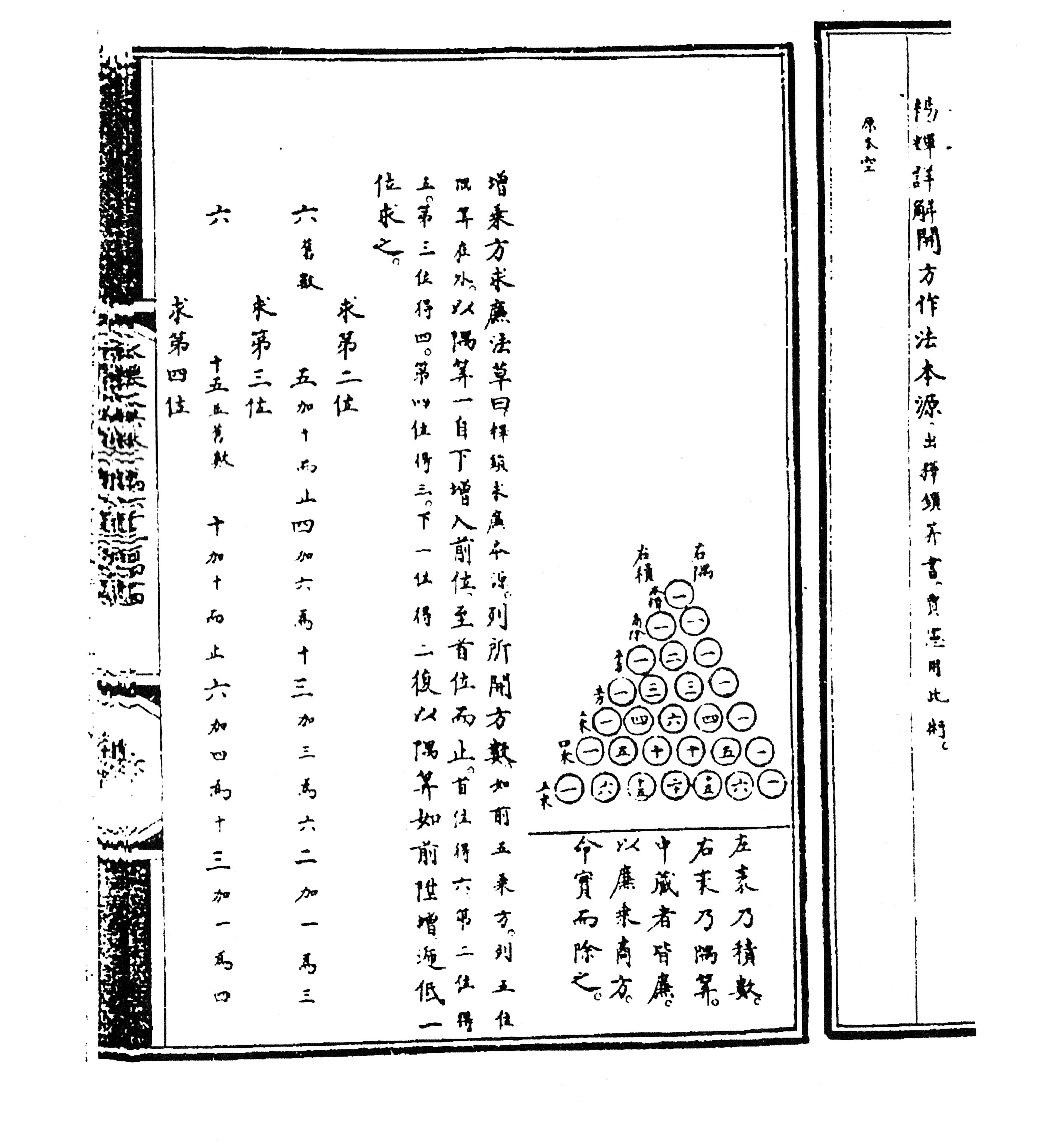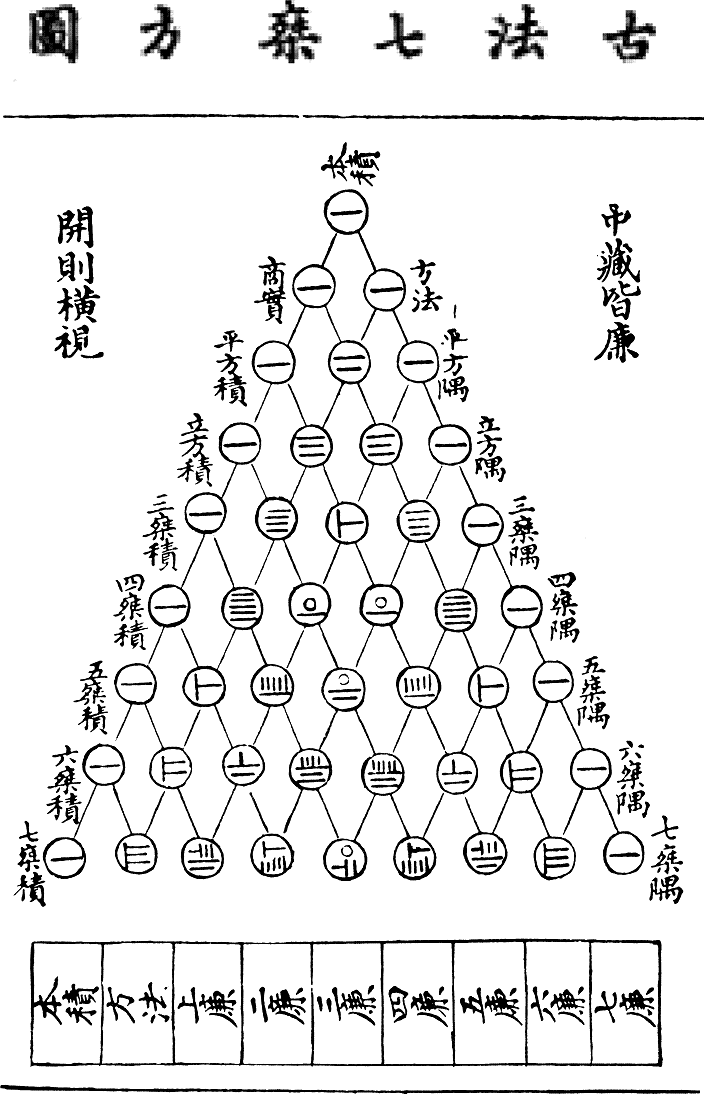|
The Ten Computational Canons
The ''Ten Computational Canons'' was a collection of ten Chinese mathematical works, compiled by early Tang dynasty mathematician Li Chunfeng (602â670), as the official mathematical texts for imperial examinations in mathematics. The Ten Computational Canons includes: #''Zhoubi Suanjing'' (''Zhou Shadow Mathematical Classic'') #''Jiuzhang Suanshu'' (''The Nine Chapters on the Mathematical Art'') #''Haidao Suanjing'' (''The Sea Island Mathematical Classic'') #''Sunzi Suanjing'' (''The Mathematical Classic of Sun Zi'') #'' Zhang Qiujian Suanjing'' (''The Mathematical Classic of Zhang Qiujian'') #'' Wucao Suanjing'' (''Computational Canon of the Five Administrative Sections'') #''Xiahou Yang Suanjing'' (''The Mathematical Classic of Xiahou Yang'') #'' Wujing Suanshu'' (''Computational Prescriptions of the Five Classics'') #''Jigu Suanjing'' (''Continuation of Ancient Mathematical Classic'') #'' Zhui Shu'' (''Method of Interpolation'') It was specified in Tang dynasty laws on examina ... [...More Info...] [...Related Items...] OR: [Wikipedia] [Google] [Baidu] |
Tang Dynasty
The Tang dynasty (, ; zh, t= ), or Tang Empire, was an Dynasties in Chinese history, imperial dynasty of China that ruled from 618 to 907 AD, with an Zhou dynasty (690â705), interregnum between 690 and 705. It was preceded by the Sui dynasty and followed by the Five Dynasties and Ten Kingdoms period. Historians generally regard the Tang as a high point in Chinese civilization, and a Golden age (metaphor), golden age of cosmopolitan culture. Tang territory, acquired through the military campaigns of its early rulers, rivaled that of the Han dynasty. The House of Li, LÇ family () founded the dynasty, seizing power during the decline and collapse of the Sui Empire and inaugurating a period of progress and stability in the first half of the dynasty's rule. The dynasty was formally interrupted during 690â705 when Empress Wu Zetian seized the throne, proclaiming the Zhou dynasty (690â705), Wu Zhou dynasty and becoming the only legitimate Chinese empress regnant. The devast ... [...More Info...] [...Related Items...] OR: [Wikipedia] [Google] [Baidu] |
Jia Xian
Jia Xian (; ca. 1010â1070) was a Chinese mathematician from Kaifeng of the Song dynasty. Biography According to the history of the Song dynasty, Jia was a palace eunuch of the Left Duty Group. He studied under the mathematician Chu Yan, and was well versed in mathematics, writing many books on the subject. Jia Xian described the Pascal's triangle (Jia Xian triangle) around the middle of the 11th century, about six centuries before Pascal. Jia used it as a tool for extracting square and cubic roots. The original book by Jia entitled ''Shi Suo Suan Shu'' was lost; however, Jia's method was expounded in detail by Yang Hui, who explicitly acknowledged his source: "My method of finding square and cubic roots was based on the Jia Xian method in ''Shi Suo Suan Shu''." A page from the ''Yongle Encyclopedia The ''Yongle Encyclopedia'' () or ''Yongle Dadian'' () is a largely-lost Chinese ''leishu'' encyclopedia commissioned by the Yongle Emperor of the Ming dynasty in 1403 and compl ... [...More Info...] [...Related Items...] OR: [Wikipedia] [Google] [Baidu] |
Dai Zhen
Dai Zhen (, January 19, 1724 â July 1, 1777) was a Chinese philosopher of the Qing dynasty. Hailing from Xiuning, Anhui Dai was a versatile scholar who made great contributions to mathematics, geography, phonology and philosophy. His philosophical and philological critiques of Neo-Confucianism continue to be influential. In 1733, Dai was recruited by scholar Ji Yun to be one of the editors of the official encyclopedia and collection of books, Siku Quanshu. Dai's philosophical contributions included those to the Han Learning school of Evidential Learning (Evidentialism) which criticized the Song Learning school of Neo-Confucianism. In particular, two criticisms that Dai made were: First, Neo-Confucianism focused too much on introspective self-examination whereas truth was to be found in investigation of the external world. Second, he criticized the Neo-Confucian drive to eliminate human desire as an obstacle to rational investigation. Dai argued that human desire was a goo ... [...More Info...] [...Related Items...] OR: [Wikipedia] [Google] [Baidu] |
Qing Dynasty
The Qing dynasty ( ), officially the Great Qing,, was a Manchu-led imperial dynasty of China and the last orthodox dynasty in Chinese history. It emerged from the Later Jin dynasty founded by the Jianzhou Jurchens, a Tungusic-speaking ethnic group who unified other Jurchen tribes to form a new "Manchu" ethnic identity. The dynasty was officially proclaimed in 1636 in Manchuria (modern-day Northeast China and Outer Manchuria). It seized control of Beijing in 1644, then later expanded its rule over the whole of China proper and Taiwan, and finally expanded into Inner Asia. The dynasty lasted until 1912 when it was overthrown in the Xinhai Revolution. In orthodox Chinese historiography, the Qing dynasty was preceded by the Ming dynasty and succeeded by the Republic of China. The multiethnic Qing dynasty lasted for almost three centuries and assembled the territorial base for modern China. It was the largest imperial dynasty in the history of China and in 1790 the f ... [...More Info...] [...Related Items...] OR: [Wikipedia] [Google] [Baidu] |
Qianlong Emperor
The Qianlong Emperor (25 September 17117 February 1799), also known by his temple name Emperor Gaozong of Qing, born Hongli, was the fifth Emperor of the Qing dynasty and the fourth Qing emperor to rule over China proper, reigning from 1735 to 1796. The fourth son of the Yongzheng Emperor, he reigned officially from 11 October 1735 to 8 February 1796. In 1796, he abdicated in favour of his son, the Jiaqing Emperor, out of filial piety towards his grandfather, the Kangxi Emperor, who ruled for 61 years, so that he not officially usurp him as the longest-reigning emperor. Despite his retirement, however, the Qianlong Emperor retained ultimate power as the Emperor Emeritus until his death in 1799, making him one of the longest-reigning monarchs in history, and dying at the age of 87, one of the longest-lived. As a capable and cultured ruler inheriting a thriving empire, during his long reign, the Qing Empire reached its most splendid and prosperous era, boasting a large popul ... [...More Info...] [...Related Items...] OR: [Wikipedia] [Google] [Baidu] |
Yongle Encyclopedia
The ''Yongle Encyclopedia'' () or ''Yongle Dadian'' () is a largely-lost Chinese ''leishu'' encyclopedia commissioned by the Yongle Emperor of the Ming dynasty in 1403 and completed by 1408. It comprised 22,937 manuscript rolls or chapters, in 11,095 volumes. Fewer than 400 volumes survive today, comprising about 800 chapters (rolls), or 3.5 percent of the original work. Most of it was lost in the 2nd half of the 19th century, in the midst of events as Second Opium War, the Boxer Rebellion and subsequent social unrests. Its sheer scope and size made it the world's largest general encyclopedia until it was surpassed by Wikipedia in late 2007, nearly six centuries later. Background Although known for his military achievements, the Yongle Emperor was an intellectual who enjoyed reading.Christos, Lauren. "The Yongle Dadian: The Origin, Destruction, Dispersal, and Reclamation of a Chinese Cultural Treasure." ''Journal of Library and Information Science'' 36, no. 1 (April 2010): 85. ... [...More Info...] [...Related Items...] OR: [Wikipedia] [Google] [Baidu] |
Yongle Emperor
The Yongle Emperor (; pronounced ; 2 May 1360 â 12 August 1424), personal name Zhu Di (), was the third Emperor of the Ming dynasty, reigning from 1402 to 1424. Zhu Di was the fourth son of the Hongwu Emperor, the founder of the Ming dynasty. He was originally enfeoffed as the Prince of Yan () in May 1370,Chan Hok-lam.Legitimating Usurpation: Historical Revisions under the Ming Yongle Emperor (r. 14021424). ''The Legitimation of New Orders: Case Studies in World History''. Chinese University Press, 2007. . Accessed 12 October 2012. with the capital of his princedom at Beiping (modern Beijing). Zhu Di was a capable commander against the Mongols. He initially accepted his father's appointment of his eldest brother Zhu Biao and then Zhu Biao's son Zhu Yunwen as crown prince, but when Zhu Yunwen ascended the throne as the Jianwen Emperor and began executing and demoting his powerful uncles, Zhu Di found pretext for rising in rebellion against his nephew. Assisted in large part ... [...More Info...] [...Related Items...] OR: [Wikipedia] [Google] [Baidu] |
Ming Dynasty
The Ming dynasty (), officially the Great Ming, was an Dynasties in Chinese history, imperial dynasty of China, ruling from 1368 to 1644 following the collapse of the Mongol Empire, Mongol-led Yuan dynasty. The Ming dynasty was the last orthodox dynasty of China ruled by the Han Chinese, Han people, the majority ethnic group in China. Although the primary capital of Beijing fell in 1644 to a rebellion led by Li Zicheng (who established the short-lived Shun dynasty), numerous rump state, rump regimes ruled by remnants of the House of Zhu, Ming imperial familyâcollectively called the Southern Mingâsurvived until 1662. The Ming dynasty's founder, the Hongwu Emperor (r. 1368â1398), attempted to create a society of self-sufficient rural communities ordered in a rigid, immobile system that would guarantee and support a permanent class of soldiers for his dynasty: the empire's standing army exceeded one million troops and the naval history of China, navy's dockyards in Nanjin ... [...More Info...] [...Related Items...] OR: [Wikipedia] [Google] [Baidu] |
Zhu Shijie
Zhu Shijie (, 1249â1314), courtesy name Hanqing (), pseudonym Songting (), was a Chinese mathematician and writer. He was a Chinese mathematician during the Yuan Dynasty. Zhu was born close to today's Beijing. Two of his mathematical works have survived. ''Introduction to Computational Studies'' ( ''Suan hsĂŒeh Ch'i-mong''), and ''Jade Mirror of the Four Unknowns''. ''Suanxue qimeng'' The ''Suan hsĂŒeh Ch'i-mong'' (), written in 1299, is an elementary textbook on mathematics in three volumes, 20 chapters and 259 problems. This book also showed how to measure different two-dimensional shapes and three-dimensional solids. The ''Introduction'' had an important influence on the development of mathematics in Japan. The book was once lost in China until Qing dynasty mathematician Luo Shilin bought a Korean printed edition, and re-published in Yangzhou. Since then this book was reprinted several times. ''Jade Mirror of the Four Unknowns'' Zhu's second book, ''Jade Mirror of the ... [...More Info...] [...Related Items...] OR: [Wikipedia] [Google] [Baidu] |
Li Zhi (mathematician)
Li Ye (; 1192â1279), born Li Zhi (), courtesy name Li Jingzhai (),Breard, Andrea. (Jan 01, 2021).Li Ye: Chinese mathematician. ''Encyclopaedia Britannica''. Accessed 7 February 2021.Li, Ye (1192-1279) æ, ć¶ (1192-1279) IdRef: ''Identifiants et RĂ©fĂ©rentials pour l'enseignement supĂ©rieur et la recherche'' (French). Accessed 19 February 2018. was a Chinese scientist and writer who published and improved the method for solving s of one variable. [...More Info...] [...Related Items...] OR: [Wikipedia] [Google] [Baidu] |
Yang Hui
Yang Hui (, ca. 1238â1298), courtesy name Qianguang (), was a Chinese mathematician and writer during the Song dynasty. Originally, from Qiantang (modern Hangzhou, Zhejiang), Yang worked on magic squares, magic circles and the binomial theorem, and is best known for his contribution of presenting Yang Hui's Triangle. This triangle was the same as Pascal's Triangle, discovered by Yang's predecessor Jia Xian. Yang was also a contemporary to the other famous mathematician Qin Jiushao. Written work The earliest extant Chinese illustration of 'Pascal's triangle' is from Yang's book ''Xiangjie Jiuzhang Suanfa'' ()Fragments of this book was retained in the Yongle Encyclopedia vol 16344, in British Museum Library of 1261 AD, in which Yang acknowledged that his method of finding square roots and cubic roots using "Yang Hui's Triangle" was invented by mathematician Jia XianNeedham, Volume 3, 134-137. who expounded it around 1100 AD, about 500 years before Pascal. In his book (now los ... [...More Info...] [...Related Items...] OR: [Wikipedia] [Google] [Baidu] |







